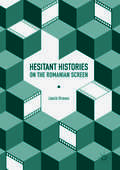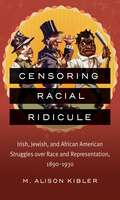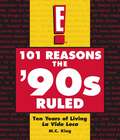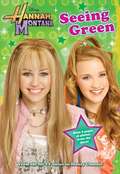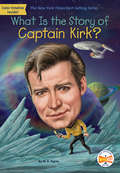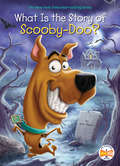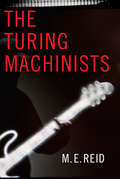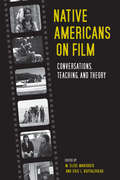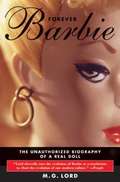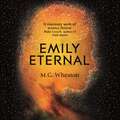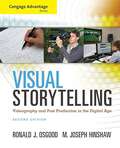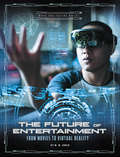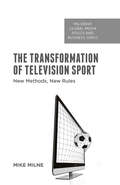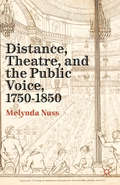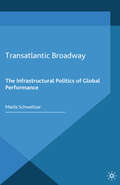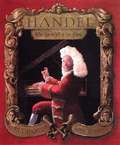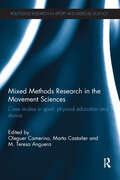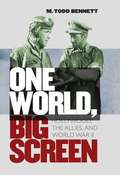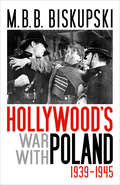- Table View
- List View
The Secret Of Chess
by Lyudmil TsvetkovLearn the secrets of chess from the only person able to beat the world number 1 chess engine Stockfish. Learn chess 5 times easier through pattern recognition. Attain deep chess knowledge in an intuitive way through a wealth of diagrams(more than 500). Read about topics no other chess author has ever discussed in the past. This book is an entertaining story, combining in one all the elements of positional evaluation in chess. Learn things from the future of chess. Learning straight from the author who has contributed a lot for the development of the strongest chess engine on Earth, Stockfish.
Hesitant Histories on the Romanian Screen
by László StrauszThis book argues that hesitation as an artistic and spectatorial strategy connects various screen media texts produced in post-war Romania. The chapters draw a historical connection between films made during the state socialist decades, televised broadcasts of the 1989 Romanian revolution, and films of the new Romanian cinema. The book explores how the critical attitude of new Romanian cinema demonstrates a refusal to accept limiting, binary discourses rooted in Cold War narratives. Strausz argues that hesitation becomes an attempt to overcome restrictive populist narratives of the past and present day. By employing a performative and mobile position, audiences are encouraged to consider conflicting approaches to history and social transformation.
Censoring Racial Ridicule
by M. Alison KiblerA drunken Irish maid slips and falls. A greedy Jewish pawnbroker lures his female employee into prostitution. An African American man leers at a white woman. These and other, similar images appeared widely on stages and screens across America during the early twentieth century. In this provocative study, M. Alison Kibler uncovers, for the first time, powerful and concurrent campaigns by Irish, Jewish and African Americans against racial ridicule in popular culture at the turn of the twentieth century. Censoring Racial Ridicule explores how Irish, Jewish, and African American groups of the era resisted harmful representations in popular culture by lobbying behind the scenes, boycotting particular acts, and staging theater riots. Kibler demonstrates that these groups' tactics evolved and diverged over time, with some continuing to pursue street protest while others sought redress through new censorship laws. Exploring the relationship between free expression, democracy, and equality in America, Kibler shows that the Irish, Jewish, and African American campaigns against racial ridicule are at the roots of contemporary debates over hate speech.
Fantasies of the Master Race: Literature, Cinema and the Colonization of American Indians
by Ward Churchill M. Annette JaimesIn this volume of incisive essays, Ward Churchill looks at representations of American Indians in literature and film, delineating a history of cultural propaganda that has served to support the continued colonization of Native America. During each phase of the genocide of American Indians, the media has played a critical role in creating easily digestible stereotypes of Indians for popular consumption. Literature about Indians was first written and published in order to provoke and sanctify warfare against them. Later, the focus changed to enlisting public support for "civilizing the savages," stripping them of their culture and assimilating them into the dominant society. Now, in the final stages of cultural genocide, it is the appropriation and stereotyping of Native culture that establishes control over knowledge and truth.
101 Reasons the '90s Ruled: Ten Years of Living La Vida Loca
by M. C. KingThe '90s were so money! Sit back and relive ten of the best years of your so-called life... Presidential scandals, rap feuds, Baywatch -- the '90s had it all. It was the decade during which we first visited 90210 and had coffee with our Friends. We got on the Web and started to Google and lol. We learned that a show about nothing can definitely be something, and that men and women hail from different planets! (Who knew?) And for at least a second or two, we may have wondered whether the Blair Witch was real. The perfect companion to E!'s 101 Reasons the '90s Ruled miniseries, this book relives memorable moments from a momentous decade. Every page will make you say, "Dude, I totally remember that." Unless, of course, you are very, very young (or don't call people dude). Packed with cool photos and irreverent commentary, 101 Reasons the '90s Ruled is Absolutely Fabulous.
Seeing Green (Disney's Hannah Montana #8)
by M. C. KingEgomaniac! All the girls at Seaview think fellow student and TV actor and Jake Ryan is a hottie, but Miley thinks his ego is out of control. So when he asks her to a school dance, she says no. Then Miley appears as Hannah Montana on his TV series and realizes she might have misjudged him. Before she can admit a change of heart, Jake asks out her friend Lilly! After Miley's jealousy leads to a major fight with Lilly, she realizes she may have lost her best friend and her dream guy! Is it too late to get them back
Superstar Secrets (Disney's Hannah Montana #18)
by M. C. KingJake Ryan is in town, and he's doing his best to win back Miley's affection. He's showering her with gifts and flowers, but she isn't convinced; at least not until Jake announces his feelings for her on national TV! Now that his secret is out, Miley has to decide if she should trust him with her biggest secret: she's Hannah Montana! Or should she keep quiet and risk losing Jake again? Plus, Miley discovers that dating celebrity Jake Ryan is a lot more work than she'd ever imagined!
What Is the Story of Captain Kirk? (What Is the Story Of?)
by Who HQ M. D. PayneYour favorite characters are now part of the Who HQ library!Journey to deep space and learn how James Tiberius Kirk became one of the greatest space heroes in the Star Trek universe in this addition to the New York Times bestselling series.From appearances in live action and animated television shows, a series of films, comics, video games, and more, James T. Kirk is an established space captain in pop culture. Star Trek remains one of the most popular science-fiction series of all time, and Captain Kirk is one of the most famous and highly decorated captains in the history of Starfleet. As the commanding officer of starships like the U.S.S. Enterprise, viewers follow his adventures through space. But did you know that Kirk wasn't even the show's first Captain? And that the Star Trek series almost didn't happen? Author M. D. Payne takes readers aboard Starfleet starships as Kirk explores new worlds, encounters new villains, and "boldly goes where no man has gone before."
What Is the Story of Scooby-Doo? (What Is the Story Of?)
by Who HQ M. D. PayneYour favorite characters are now part of the Who HQ library! Nothing mysterious about it! Learn all about how Scooby and his friends took over Saturday mornings--and then the world--in this debut title in the What Is the Story Of? series.Most kids are familiar with the always-hungry, scaredy-cat Great Dane called Scooby-Doo and his true-blue friends of Mystery Inc. But how did Scooby and the gang make it onto the silver screen? Author M. D. Payne lays out the whole groovy tale in this book that's sure to have readers shouting, "Zoinks!"
The Turing Machinists
by M. E. ReidAt seventeen, Del’s world seems to be falling apart. He’s managed his Asperger’s well, has a solid group of friends in his special needs class at school, and even manages to get by among people who don’t understand his brand of communication. But his parents are splitting up, and Del is certain he can save his family. To do it, he decides he needs to live out his father’s dream of musical stardom. He gets together with some of his friends and they form The Turing Machinists, an all-Asperger’s rock band. But they’ll need help – and Del seeks that help in the form of his neighbour, a reclusive rock legend who would rather have nothing to do with the music scene.
Native Americans on Film: Conversations, Teaching, and Theory
by M. Elise Marubbio and Eric L. Buffalohead“An essential book for courses on Native film, indigenous media, not to mention more general courses . . . A very impressive and useful collection.” —Randolph Lewis, author of Navajo Talking PictureThe film industry and mainstream popular culture are notorious for promoting stereotypical images of Native Americans: the noble and ignoble savage, the pronoun-challenged sidekick, the ruthless warrior, the female drudge, the princess, the sexualized maiden, the drunk, and others. Over the years, Indigenous filmmakers have both challenged these representations and moved past them, offering their own distinct forms of cinematic expression.Native Americans on Film draws inspiration from the Indigenous film movement, bringing filmmakers into an intertextual conversation with academics from a variety of disciplines. The resulting dialogue opens a myriad of possibilities for engaging students with ongoing debates: What is Indigenous film? Who is an Indigenous filmmaker? What are Native filmmakers saying about Indigenous film and their own work? This thought-provoking text offers theoretical approaches to understanding Native cinema, includes pedagogical strategies for teaching particular films, and validates the different voices, approaches, and worldviews that emerge across the movement.“Accomplished scholars in the emerging field of Native film studies, Marubbio and Buffalohead . . . focus clearly on the needs of this field. They do scholars and students of Native film a great service by reprinting four seminal and provocative essays.” —James Ruppert, author of Meditation in Contemporary Native American Literature“Succeed[s] in depicting the complexities in study, teaching, and creating Native film . . . Regardless of an individual’s level of knowledge and expertise in Native film, Native Americans on Film is a valuable read for anyone interested in this topic.” —Studies in American Indian Literatures
Forever Barbie: The Unauthorized Biography Of A Real Doll
by M. G. LordSince Barbie's introduction in 1959, her impact on baby boomers has been revolutionary. Far from being a toy designed by men to enslave women, she was a toy invented by women to teach women what-for better or worse-was expected of them. In telling Barbie's fascinating story, cultural critic and investigative journalist M. G. Lord, herself a first-generation Barbie owner, has written a provocative, zany, occasionally shocking book that will change how you look at the doll and the world.
Emily Eternal
by M. G. WheatonMeet Emily - she can solve advanced mathematical problems, unlock the mind's deepest secrets and even fix your truck's air con, but unfortunately, she can't restart the Sun.She's an artificial consciousness, designed in a lab to help humans process trauma, which is particularly helpful when the sun begins to die 5 billion years before scientists agreed it was supposed to.So, her beloved human race is screwed, and so is Emily. That is, until she finds a potential answer buried deep in the human genome. But before her solution can be tested, her lab is brutally attacked, and Emily is forced to go on the run with two human companions - college student Jason and small-town Sheriff, Mayra.As the sun's death draws near, Emily and her friends must race against time to save humanity. But before long it becomes clear that it's not only the species at stake, but also that which makes us most human.
Detoxing Masculinity in Anglophone Literature and Culture: In Search of Good Men
by Sara Martín M. Isabel SantaulàriaThis edited volume rethinks Masculinity Studies by breaking away from the notion of the perpetual crisis of masculinity. It argues that not enough has been done to distinguish patriarchy from masculinity and proposes to detox masculinity by offering a collection of positive representations of men in fictional and non-fictional texts. The editors show how ideas of hegemonic and toxic masculinity have been too fixed on the exploration of dominance and subservience, and too little on the men (and the male characters in fiction) who behave following other ethical, personal and socially accepted patterns. Bringing together research from different periods and genres, this collection provides broad, multidisciplinary insights into alternative representations of masculinity.
Visual Storytelling: Videography and Post Production in the Digital Age
by Ronald J. Osgood M. Joseph HinshawVISUAL STORYTELLING: VIDEOGRAPHY AND POST PRODUCTION IN THE DIGITAL AGE SECOND EDITION combines a thorough exploration of essential storytelling concepts with detailed instruction in practical technical skills. Without limiting its focus to a particular range of equipment, applications, or technology, this engaging text covers the key concepts, aesthetics, and techniques of single-camera field production and post production, and includes real-life stories and suggestions from working professionals.
The Future of Entertainment: From Movies to Virtual Reality (What the Future Holds)
by M. M. EbochFrom stage productions to television to movies, humans have always been entertained by a good story. But how might entertainment change in the future? From immersive virtual reality games to social media with 3-D holograms, readers can find out what cool new technologies might change the way they are entertained.
The Transformation of Television Sport: New Methods, New Rules (Palgrave Global Media Policy and Business)
by M. MilneThe Transformation of Television Sport: New Methods, New Rules examines how developments in technology, broadcasting rights and regulation combine to determine what sport we see on television, where we can see it and what the final output looks and sounds like.
Distance, Theatre, and the Public Voice, 1750–1850
by M. NussAs theatres expanded in the eighteenth and nineteenth centuries, the distance between actor and audience became a telling metaphor for the distance emerging between writers and readers. Nuss explores the ways in which theatre helped authors imagine connecting with a new mass audience.
Transatlantic Broadway: The Infrastructural Politics of Global Performance (Transnational Theatre Histories)
by M. SchweitzerTransatlantic Broadway traces the infrastructural networks and technological advances that supported the globalization of popular entertainment in the pre-World War I period, with a specific focus on the production and performance of Broadway as physical space, dream factory, and glorious machine.
Go High: The Unstoppable Presence and Poise of Michelle Obama
by M. SweeneyA photographic celebration of the elegance and inspiring strength of former First Lady Michelle Obama.Featuring more than fifty full-color photographs illustrating her warmth, wisdom, and belief in a bright future, this one-of-a-kind collection highlights Michelle Obama’s compassion, verve, and dynamic approach to unifying people from all walks of life. Each picture is accompanied by some of her most compelling words—inspirational quotes sharing her earnest belief that the United States of America is a place of unity, fairness, vitality, and optimism.A perfect gift for mothers and graduates, Go High revisits the beloved first lady’s heartfelt embrace of the American people, and her persistent encouragement to always lift one another up, reach higher, and rise to the occasion.
Handel, Who Knew What He Liked
by M. T. AndersonA droll biography reveals the high notes--and the low notes- in the life of the world's foremost composer of Baroque music. This is not your usual picture book biography. Nor was George Frideric Handel your everyday eighteenth-century composer. This witty and yet rigorously researched and accessible biography captures Handel's essential spirit--from a child who smuggled a clavichord into the attic to play music against his father's orders to a young man who imported forty-five pounds of mountain snow to chill wine for a gala--as well as his remarkable, enduring musical triumphs. But M. T. Anderson also shows Handel's struggles and chronicles the illness, ill fortune, and despair that led to his greatest achievement, the Messiah.
Mixed Methods Research in the Movement Sciences: Case Studies in Sport, Physical Education and Dance (Routledge Research in Sport and Exercise Science)
by Oleguer Camerino Marta Castañer M. Teresa AngueraMixed methods research techniques, combining both quantitative and qualitative elements, have become well established throughout the social, behavioural and natural sciences. This is the first book to focus on the application of mixed methods research in the movement sciences, specifically in sport, physical education and dance. Researchers and practitioners in each of these fields are concerned with the study of habitual behaviour in naturalistic contexts, and of the concurrent and sequential nature of events and states, precisely the kind of work that multi-method research design can help illuminate. The book is arranged into four sections. The first provides a thorough overview of mixed methods procedures and research design, and summarizes their applicability to the movement sciences. The remaining sections then offer detailed case studies of mixed methods research in team and individual sports (analyzing hidden patterns of play and optimising technique); kinesics and dance (analyzing motor skills behaviour in childhood, and the complexity of motor responses in dance); and physical education (detecting interaction patterns in group situations, and optimizing non-verbal communication by teachers and sports coaches). Mixed Methods Research in the Movement Sciences offers an important new tool for researchers and helps to close the gap between the analysis of expert performance and our understanding of the general principles of movement science. It is important reading for any student, researcher or professional with an interest in motor control, sport and dance pedagogy, coaching, performance analysis or decision-making in sport.
One World, Big Screen
by M. Todd BennettWorld War II coincided with cinema's golden age. Movies now considered classics were created at a time when all sides in the war were coming to realize the great power of popular films to motivate the masses. Through multinational research, One World, Big Screen reveals how the Grand Alliance--Britain, China, the Soviet Union, and the United States--tapped Hollywood's impressive power to shrink the distance and bridge the differences that separated them. The Allies, M. Todd Bennett shows, strategically manipulated cinema in an effort to promote the idea that the United Nations was a family of nations joined by blood and affection. Bennett revisits Casablanca, Mrs. Miniver, Flying Tigers, and other familiar movies that, he argues, helped win the war and the peace by improving Allied solidarity and transforming the American worldview. Closely analyzing film, diplomatic correspondence, propagandists' logs, and movie studio records found in the United States, the United Kingdom, and the former Soviet Union, Bennett rethinks traditional scholarship on World War II diplomacy by examining the ways that Hollywood and the Allies worked together to prepare for and enact the war effort.
Hollywood's War with Poland, 1939–1945
by M.B.B. Biskupski&“This passionate, carefully researched, richly detailed, well-written study&” reveals the political motives behind WWII Hollywood&’s portrayal of Poles (Choice). During World War II, Hollywood studios supported the war effort by making patriotic movies designed to raise the nation's morale. Often the characterizations were as black and white as the movies themselves: Americans and their allies were heroes, while everyone else was a villain. The peoples of Norway, France, Czechoslovakia, and England were all good because they had been invaded or victimized by Nazi Germany. Yet Poland—the first country to be invaded by the Third Reich—was repeatedly represented in a negative light. In this prize-winning study, Polish historian M. B. B. Biskupski explores why. Biskupski presents a close critical study of prewar and wartime films such as To Be or Not to Be, In Our Time, and None Shall Escape. Through memoirs, letters, diaries, and memoranda written by screenwriters, directors, studio heads, and actors, Biskupski examines how the political climate, and especially pro-Soviet sentiment, influenced Hollywood films of the time. Winner of the Oscar Halecki PrizeA Choice Outstanding Academic Title
Forever Barbie: The Unauthorized Biography Of A Real Doll
by M.G. LordBarbie is a strong, independent doll. But is she a feminist icon? It’s complicated. Since her introduction in 1959, Barbie’s impact has been revolutionary. Far from being a toy designed by men to oppress women, she was a toy invented by women to teach women what was expected of them, for better or for worse. Whether tarred-and-glittered as antifeminist puffery or celebrated as a feminist icon (or, at any rate, an important cultural touchstone in understanding feminism) Barbie has undeniably influenced generations of girls. In Forever Barbie, cultural critic, investigative journalist, and first-generation Barbie owner M. G. Lord uncovers the surprising story behind Barbie’s smash success. Revealing her low origins as “Bild Lilli,” a risqué doll for adults sold as a gag gift in postwar Germany, Forever Barbie traces Barbie’s development and transformation, through countless makeovers and career changes, into an international pop culture icon and now “traditional toy.” Though not every doll in the line has been a hit—with pregnant Midge and Growing up Skipper among the more intriguing disasters—Barbie’s endurance, Lord writes, speaks as much to Mattel’s successful marketing as it does to our society’s overall ambivalence toward femininity. With new accessories, including a preface on the latest developments in the Barbieverse, Forever Barbie “will make you think of America’s most celebrated plastic doll in ways you never have before” (Susan Faludi).

